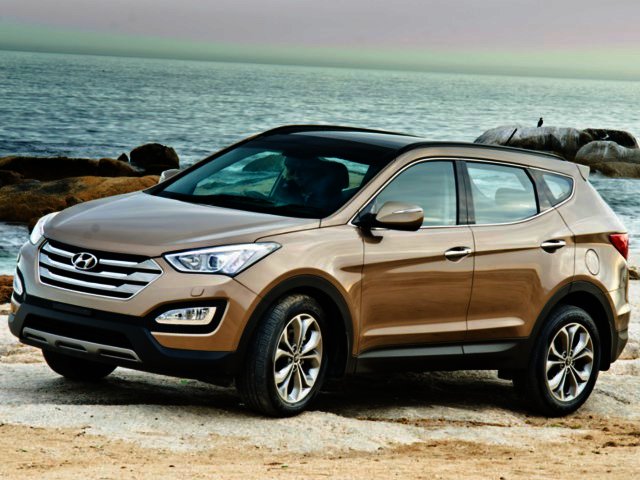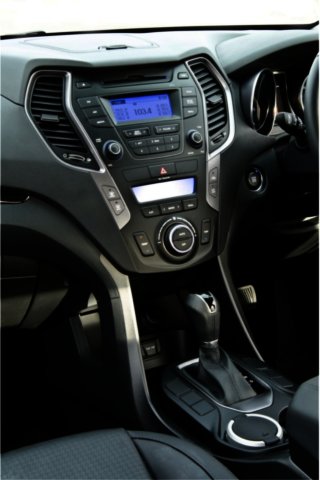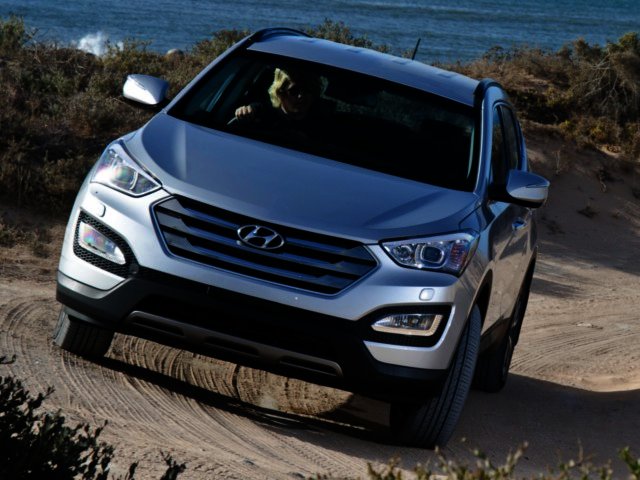Hyundai 3rd generation Santa Fe - First Impressions
By Hanleigh Daniels 28 January 2013 | Categories: news
Hyundai South Africa has launched the all-new, third generation Hyundai Santa Fe at a function held in St Helena Bay last week. With its striking new styling and capable performance on- and off-road, the Santa Fe makes for a compelling contender in the large SUV (sports utility vehicle) segment.
Local buyers have a choice between the front-wheel drive Santa Fe Premium as well as two all-wheel drive derivatives – namely the Executive and Elite. When carrying more passengers is a priority, both the Executive as well as the Elite boast a third row of seats that neatly folds away into the cargo floor in the rear.
New car, new look
The new Santa Fe builds upon Hyundai’s “Fluidic Sculpture” design philosophy, employed to good effect on the eye-catching i30. Hyundai refers to the styling as “Storm Edge”, with the incredibly stylish look highlighted by its bold hexagonal front grille, rectangular lenses for the front Xenon headlights and curve-loving design.
At the back, the Santa Fe is as much of a head turner with its sporty twin muffler and double exhaust tips, a diffuser style moulding beneath the bumper, and LED high-level brake light. The only design element we did not like so much was the small rear window as it limits visibility.
Countering this is the Santa Fe’s Rear Parking Assist System (RPAS) that uses ultrasonic sensors to determine the proximity of vehicles or objects behind you, helping you avoid objects such as poles for instance whilst parking.
Elite models also come with a rear view camera for enhanced visibility whilst backing up. Boot space in the all-new Santa Fe is an impressive 1 003 litres in the Premium 5-seater, and 994 litres in the 7-seater Executive and Elite.

Smooth operator
A big SUV needs a capable powerplant and the new Santa Fe has one in its efficient 2.2 litre, 4-cylinder turbodiesel, which is employed within all three derivatives and features an advanced third-generation common-rail fuel injection system as well as a high-efficiency electronic turbocharger.
The 16-valve R2.2 engine with double overhead camshafts delivers 145 kW of peak power output at a low 3 800 RPM, coupled with plenty of torque (436 Nm) when the engine runs between 1 800 and 2 500 RPM. Hyundai’s fuel consumption figures are around eight litres per 100 km for the Premium FWD model and 8.3 litres per 100 km for the all-wheel drive Executive and Elite derivatives on a combined cycle.
During normal driving conditions such as town or highway driving, the all-wheel drive system in the Executive and Elite delivers power through the front wheels for optimum fuel efficiency. When you encounter more difficult terrain such as slippery, wet surfaces or gravel roads, then the Santa Fe engages the rear wheels automatically.
At home on- and off-road
Also onboard is a 4WD lock mode selector that distributes power in a 50:50 ratio to front and rear wheels for increased off-road ability. During our road trip from Cape Town International to the luxurious Shelley Point Hotel & Spa in St Helena Bay we got a chance to test out this mode on gravel roads as well as some off-road driving at Trekoskraal, near Paternoster. We were surprised by how easily the big SUV coped with the rougher terrain, slopes, and loose sand, particularly as it is lacking low-range.
On road, the big car still comes across as agile, while steering felt comfortable and light, though not nearly as light as on the Hyundai i30. As on the i30, a Flex Steer system offers three steering modes that are selectable via a switch on the steering wheel, enabling the driver to choose between Comfort, Normal and Sport according to road conditions. Unfortunately we did not get an opportunity to test this feature yet.
Helping you to holding onto the reigns of the Santa Fe on slippery roads is Hyundai’s Traction Control System (TCS) that prevents the wheel from spinning in an uncontrolled manner, while the Vehicle Stability Management (VSM) is also standard equipment. VSM promotes stable car manoeuvring and optimal safety during situations where there is a high potential for skidding.
Additional active safety systems include Electronic Stability Program, and Hill-start Assist Control (HAC) system (standard across the range) that is capable of detecting an incline and automatically apply the brakes to prevent dangerous rollback. Complementing HAC is Downhill Brake Control that assists vehicle control during steep forward movement.

Pricing
The prices of the all-new Hyundai Santa Fe range are:
Santa Fe R2.2 Premium FWD 5-seater R434 900
Santa Fe R2.2 Executive AWD 7-seater R459 900
Santa Fe R2.2 Elite AWD 7-seater R499 900
This pricing puts the Santa Fe right up against some tough SUV competition including Audi’s Q5, the Toyota Fortuner, Chevrolet Trailblazer and BMW’s X3. While we feel that the all-new Santa Fe is able to go toe-to-toe with these rivals in terms of handling and design, it is in the value aspect where Hyundai once again has most to offer.
The Santa Fe R2.2 AWD Elite for instance costs R499 900, and whilst both Audi’s 2.0 TDI S Tronic (R477 000) and BMW’s X3 xDrive20d Dsl 4x4 AT (R482 309) cost a bit less, they offer fewer standard features. In order to get the rear parking assist system with rearview camera for instance you have to fork out R12 200 on both the Audi and BMW, while your bank account will be debited with another R10 860 (to Ingolstadt) and R13 100 (in the case of the Beemer) for Xenon headlamps with washers.
Pricing also includes Hyundai’s five year or 150 000 km manufacturer’s warranty, along with a five year or 150 000 km roadside assistance plan and a five year or 90 000 km service contract. Service intervals for this vehicle are 15 000 km.
Hyundai expects to sell 150 Santa Fe cars per month and given the sublime new styling, capable handling on- and off-road, as well as the generous amount of standard kit you get with this car, we feel they will be easily able to exceed this figure.
In related news, Ford is aiming to boost the popularity of its Fiesta with the all-new 2013 edition, which sports updated styling, and introduces the company’s International Engine of the Year - the 1.0-litre EcoBoost power plant - to the Fiesta line-up.
Most Read Articles

Have Your Say
What new tech or developments are you most anticipating this year?



